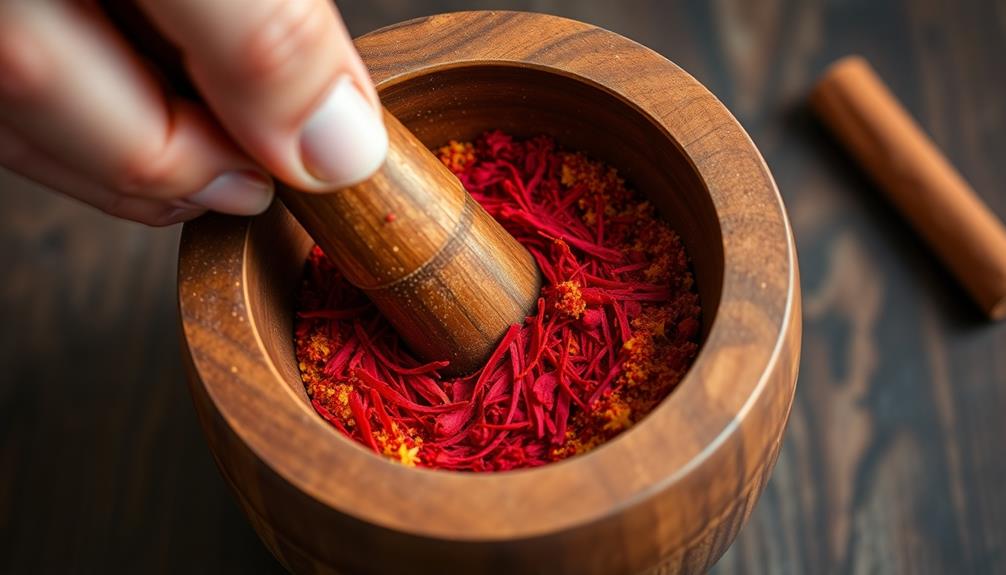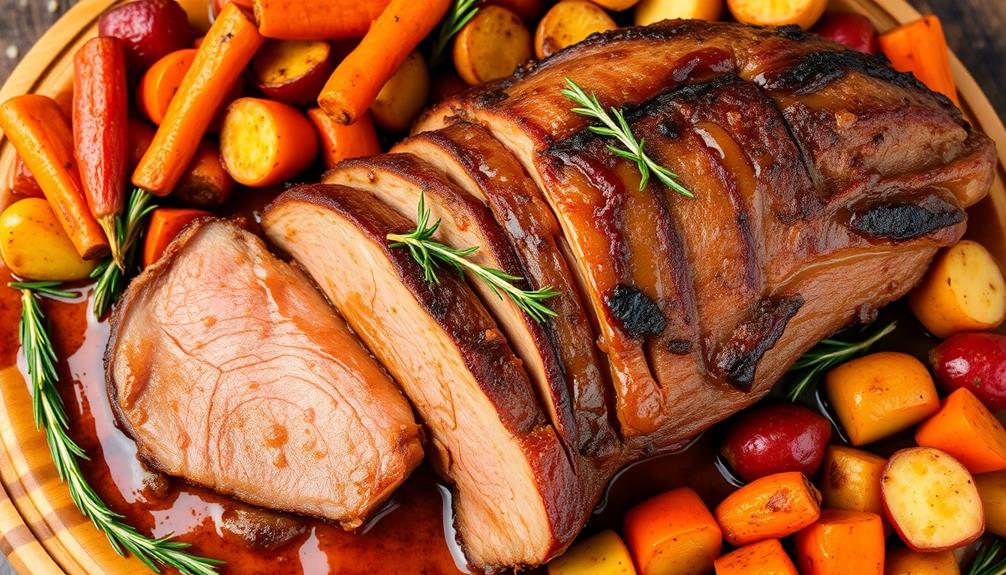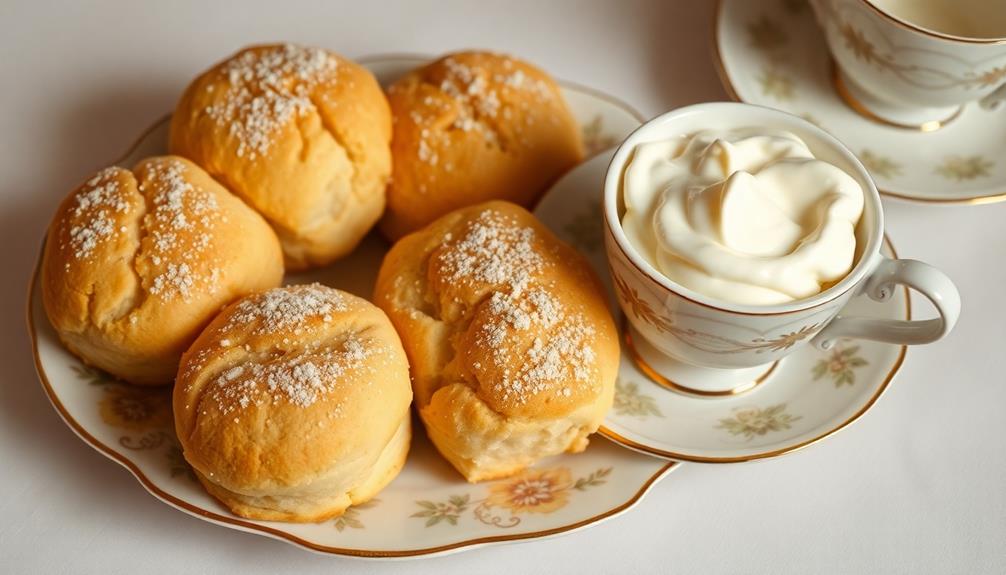During the Islamic Golden Age from the 8th to 13th centuries, medieval Islamic cuisine enjoyed a culinary renaissance. The expansion of the empire integrated diverse regional flavors, and the Abbasid dynasty fostered experimentation. Vibrant spices like saffron, cinnamon, and nutmeg transformed dishes, while honey, herbs, and nuts added depth. Signature recipes included fragrant rice pilafs, spiced stews, and marinated meats. Preservation techniques like fermentation showcased advanced culinary knowledge. This flavorful legacy influenced cuisines worldwide, and its mastery of spices and cooking methods still captivates food enthusiasts today. Delve deeper to uncover the treasures of this golden age.
Key Takeaways
- The Islamic Golden Age from the 8th to 13th century saw the expansion of the Islamic empire, integrating diverse regional cuisines from Persia to North Africa.
- Influential cookbooks, such as "The Book of Dishes," established medieval Islamic cuisine as a leader in culinary innovation, with the use of exotic spices like saffron, cinnamon, and nutmeg.
- Signature dishes included rice pilafs, spiced stews, and grilled meats, showcasing a blend of sweet, sour, and savory flavors, enhanced by dried fruits and nuts.
- Cooking techniques, such as soaking ingredients, grinding spices, and simmering, were crucial for achieving balanced flavors and tender textures in medieval Islamic cuisine.
- The cultural significance of food in medieval Islamic society as a connector to shared history, identity, and community emphasizes its lasting global influence on modern culinary trends.
History
Medieval Islamic cuisine has a rich and fascinating history. During the Islamic Golden Age, from the 8th to the 13th century, the Arab world experienced a cultural and scientific renaissance that also transformed its culinary traditions.
As the Islamic empire expanded, it absorbed diverse regional cuisines, from Persia to North Africa, and integrated them into a vibrant and sophisticated food culture.
The Abbasid dynasty, which ruled the Islamic world from 750 to 1258 CE, played a crucial role in this culinary evolution. The Abbasid court in Baghdad became a hub of gastronomic experimentation, with chefs and scholars collaborating to develop new techniques and recipes.
They drew inspiration from the spice trade, introducing exotic flavors like cinnamon, nutmeg, and saffron into their dishes. The compilation of influential cookbooks, such as the 10th-century classic "The Book of Dishes," further solidified the reputation of medieval Islamic cuisine as a global leader in culinary innovation and refinement.
Recipe
Medieval Islamic cuisine was known for its complex and sophisticated flavors, drawing from a rich tradition of spices, herbs, and cooking techniques. One such dish is the Lamb with Saffron and Cinnamon, a fragrant and flavorful stew that exemplifies the culinary prowess of the era.
The use of saffron, a precious spice imported from Persia, adds a vibrant golden hue and a distinct floral aroma to the dish. Cinnamon, another key ingredient, lends a warm, slightly sweet note that perfectly complements the richness of the lamb. This dish was often served at grand feasts and celebrations, a testament to the culinary artistry of the medieval Islamic world.
Ingredients:
- 2 lbs lamb, cut into 1-inch cubes
- 1 onion, diced
- 3 cloves garlic, minced
- 1 tbsp ground cinnamon
- 1 tsp saffron threads
- 1 cup beef or lamb stock
- 1 cup white wine
- 2 tbsp honey
- Salt and pepper to taste
Cooking Instructions:
In a large pot or Dutch oven, sauté the onion and garlic in a bit of olive oil until translucent. Add the lamb cubes and brown them on all sides.
Stir in the cinnamon and saffron, then pour in the stock and wine. Bring the mixture to a boil, then reduce the heat and simmer for 1-1.5 hours, or until the lamb is tender. Stir in the honey and season with salt and pepper to taste.
When serving this dish, consider accompanying it with fragrant basmati rice or warm flatbread to soak up the flavorful sauce. The key to achieving the authentic medieval Islamic flavor is to balance the sweet, savory, and aromatic elements, allowing the saffron and cinnamon to shine.
Cooking Steps
First, soak the ingredients in warm water to soften them.
Then, grind the spices with a mortar and pestle until they're a fine powder.
Next, sauté the ground spices before adding them to the pot, and let the dish simmer until the ingredients are tender.
Step 1. Soak Ingredients in Warm Water

Soaking the ingredients in warm water is a crucial step in medieval Islamic cuisine. It helps to soften the ingredients and extract their flavors, ensuring a more harmonious and complex final dish. Whether you're working with dried beans, lentils, or even grains, soaking them in warm water for an extended period, typically 30 minutes to an hour, will make them more tender and easier to cook.
The warm water helps to break down the tough outer layers of the ingredients, allowing the internal flavors to be released. This process also helps to remove any bitterness or unwanted notes, resulting in a more balanced and nuanced dish. Be sure to use water that's just barely warm, as excessively hot water can start to cook the ingredients prematurely.
Once the soaking is complete, drain the ingredients, discarding the soaking water, and proceed with the next steps in the recipe. This simple yet important technique is the foundation for many flavorful medieval Islamic dishes.
Step 2. Grind Spices With Mortar and Pestle

After soaking the ingredients, the next step in medieval Islamic cuisine is to grind the spices using a mortar and pestle. This method allows you to release the full essence and aroma of the spices, which is crucial for achieving the rich, complex flavors characteristic of this culinary tradition.
Begin by adding your aromatic spices, such as cinnamon, cloves, and cardamom, to the mortar. Using the pestle, grind the spices in a circular motion, applying firm pressure. Grind until you've achieved a fine, uniform powder. This process may take several minutes, but it's essential for unlocking the spices' volatile oils and essential compounds.
Once the spices are ground, you can add them to your simmering stews, rice dishes, or other preparations. The freshly ground spices will impart a depth of flavor that simply can't be replicated with pre-ground varieties.
This laborious yet rewarding step is a hallmark of medieval Islamic cuisine, ensuring each dish is a true sensory experience.
Step 3. Sauté the Ground Spices

With the spices ground to a fine powder, it's time to sauté them.
Heat a generous amount of oil or ghee in a skillet over medium heat. Once the oil shimmers, add the ground spices. Stir constantly to prevent burning, as the spices will toast quickly. You'll know they're ready when the aroma becomes fragrant and the color deepens. This process releases the essential oils, amplifying the flavors.
Adjust the heat as needed to maintain a gentle sizzle without scorching the spices. After a minute or two, the spices should be toasted and vibrant.
Remove the skillet from heat and transfer the sautéed spices to a bowl or plate to halt the cooking. Resist the temptation to skip this step, as it's crucial for developing the complex flavors that define medieval Islamic cuisine.
With the spices ready, you can now incorporate them into your dishes, unlocking the bold and aromatic essence of this culinary tradition.
Step 4. Add Ingredients to Pot

Once the spices are sautéed and ready, you can begin adding the remaining ingredients to the pot. First, add the meat or poultry, whether it's lamb, chicken, or beef. Stir the meat until it's browned on all sides, ensuring it's evenly cooked.
Next, pour in the liquid, which could be broth, water, or a combination of both. Bring the mixture to a simmer, then add the chopped vegetables like onions, garlic, and tomatoes. Stir everything together and let the flavors meld.
Don't forget to season the dish with salt and pepper to taste. You can also add more spices at this stage, such as cinnamon, cumin, or coriander, depending on the recipe.
Adjust the heat to maintain a gentle simmer, and let the dish cook until the meat is tender and the vegetables are soft.
Lastly, if the stew seems too thin, you can thicken it by making a slurry with a bit of water and cornstarch, then stirring it in until the desired consistency is achieved.
Step 5. Simmer Until Ingredients Are Tender

Now that the ingredients are in the pot, let's simmer the dish until the meat is tender and the vegetables are soft.
Adjust the heat to maintain a gentle simmer, not a rapid boil, which could make the ingredients tough. This low and slow cooking method allows the flavors to meld and the tougher cuts of meat to become meltingly tender.
Stir the pot occasionally to prevent sticking or burning. Depending on the ingredients, this simmering step could take anywhere from 30 minutes to a few hours.
Keep an eye on the liquid level and add more broth or water if needed to prevent the dish from drying out. The goal is to end up with a rich, flavorful sauce that coats the tender meat and vegetables.
Once the ingredients reach the desired tenderness, you're ready to move on to the next step in the recipe.
Final Thoughts
Reflecting on the diverse culinary traditions of medieval Islamic societies, one can't help but marvel at the intricate interplay of flavors, ingredients, and cultural influences that shaped this rich gastronomic heritage.
The dishes we've explored, from the fragrant rice pilafs to the exquisitely spiced stews, serve as a testament to the ingenuity and sophistication of medieval Arab cooks. Their mastery of preserving techniques, their deft blending of sweet, sour, and savory elements, and their innovative use of spices from across the Islamic world have left an indelible mark on global cuisine.
Though the passage of time has inevitably altered some of these traditions, the essence of medieval Islamic cooking lives on, inspiring chefs and food enthusiasts alike to explore and celebrate the enduring legacy of this culinary golden age.
As we bid farewell to this journey, we're left with a profound appreciation for the enduring power of food to connect us to our shared history and the diverse tapestry of human experience.
Frequently Asked Questions
What Were the Key Spices Used in Medieval Islamic Cuisine?
The key spices used in medieval Islamic cuisine included cinnamon, cumin, coriander, and saffron. These spices lent depth of flavor and aroma to the region's diverse array of dishes, elevating the culinary experience.
How Did Trade Routes Influence the Ingredients in Medieval Islamic Cooking?
The thriving trade routes of the medieval Islamic world brought an abundance of exotic spices, herbs, and ingredients from distant lands, dramatically shaping and enriching the flavors of the region's cuisine.
What Were the Dining Customs and Etiquette During the Medieval Islamic Era?
During the medieval Islamic era, dining customs emphasized community, hospitality, and etiquette. You'd be expected to eat with your right hand, avoid excessive noise, and demonstrate moderation – all to foster a harmonious mealtime experience.
How Did the Role of Women in the Kitchen Evolve Over Time?
As time passed, women's roles in the kitchen became more prominent. They transformed from primarily domestic helpers to skilled culinary experts, shaping the evolution of regional cuisines and passing down their knowledge to future generations.
What Were the Common Cooking Techniques Used in Medieval Islamic Kitchens?
You'll find medieval Islamic kitchens employed various cooking techniques like simmering, braising, roasting, and steaming to prepare flavorful dishes. These methods ensured meat, vegetables, and grains were cooked thoroughly and seasoned to perfection.










